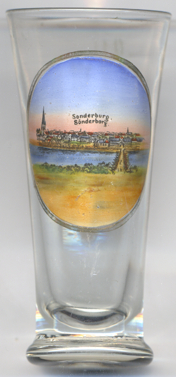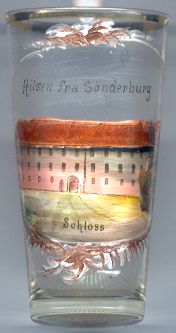

|
| DANMARK | DENMARK |
| Region Syddanmark | Region South Denmark |
 Sønderborg (German: Sonderburg) in southern Denmark is situated at the Bay of Sønderborg,
which is part of the Flensburg Fjord.
The historic town centre and large parts of the town are located at the island Als (German: Alsen), which is
separted from the mainland of Jylland (Jütland) by the narrow (250 m) Als Strait. Dybbøl (Düppel),
west of the Als Sund also is part of the municipality of Sønderborg. The municipality of Sønderborg
covers an area of about 54 km² and has a total population of about 30,000. On the 1st of January 2007,
after the Danish Municipality Reform, Sønderborg was combined with the municipalities of
Augustenborg, Broager, Gråsten, Nordborg, Sydals, and Sundeved.
Sønderborg (German: Sonderburg) in southern Denmark is situated at the Bay of Sønderborg,
which is part of the Flensburg Fjord.
The historic town centre and large parts of the town are located at the island Als (German: Alsen), which is
separted from the mainland of Jylland (Jütland) by the narrow (250 m) Als Strait. Dybbøl (Düppel),
west of the Als Sund also is part of the municipality of Sønderborg. The municipality of Sønderborg
covers an area of about 54 km² and has a total population of about 30,000. On the 1st of January 2007,
after the Danish Municipality Reform, Sønderborg was combined with the municipalities of
Augustenborg, Broager, Gråsten, Nordborg, Sydals, and Sundeved.
Glass no. 3787 [left] is labeled both in German, Sonderburg, and in Danish, however with a spelling error: Sönderborg instead of Sønderborg.
The  church of Our Lady (Sankt Marie Kirke) [left, no. 0000: far left]
was built from 1595 in place of an older church of which only a wooden wall cupboard dating from about 1400 remained.
The consecration of the new church took place in 1600. Originally dedicated to St. George, the church was dedicated
to Our Lady in 1649.
church of Our Lady (Sankt Marie Kirke) [left, no. 0000: far left]
was built from 1595 in place of an older church of which only a wooden wall cupboard dating from about 1400 remained.
The consecration of the new church took place in 1600. Originally dedicated to St. George, the church was dedicated
to Our Lady in 1649.

 Sønderborg castle [left] was probably founded as a fortified tower by
Valdemar the Great in 1158. In 1340 the small castle was expanded significantly with the addition of both the
'Blue Tower' and huge outer walls. In 1490, the fortress became the property of the Crown and was further extended.
In 1532 Christian II was lured into an ambush, and the dethroned king was held prisoner of state in the fortress
for 17 years. Between 1549 and 1557 the fortress was converted into a four-wing castle in the new Renaissance style.
The unique castle chapel was added in 1568–1570 for Queen Dorothea, widow of Christian III.
It is considered to be one of Europe's oldest and best-preserved Lutheran royal chapels.
A major conversion in Baroque style took place in 1718–1726.
The Blue Tower was demolished in 1755. In 1764 the castle passed into the hands of the Duke of Augustenborg,
but against expectations it did not became residence. Instead it was rented out as a warehouse.
During both Wars of Schleswig (1840–1850 and 1864) the castle was used as a camp hospital and for quartering Danish troops.
Between 1867 and 1918 it then served as barracks for Prussian troops. The last Duke of Augustenborg allowed
Sønderborg County Museum to move into a part of the castle in 1920. The Danish state took over the castle in 1921.
Between 1945 and 1946 the castle was used as an internment camp for persons charged for injuries to the State.
A thorough restoration of the castle was carried out from 1964 to 1973 returning it to the Baroque form it was given in the 1720s.
Sønderborg castle [left] was probably founded as a fortified tower by
Valdemar the Great in 1158. In 1340 the small castle was expanded significantly with the addition of both the
'Blue Tower' and huge outer walls. In 1490, the fortress became the property of the Crown and was further extended.
In 1532 Christian II was lured into an ambush, and the dethroned king was held prisoner of state in the fortress
for 17 years. Between 1549 and 1557 the fortress was converted into a four-wing castle in the new Renaissance style.
The unique castle chapel was added in 1568–1570 for Queen Dorothea, widow of Christian III.
It is considered to be one of Europe's oldest and best-preserved Lutheran royal chapels.
A major conversion in Baroque style took place in 1718–1726.
The Blue Tower was demolished in 1755. In 1764 the castle passed into the hands of the Duke of Augustenborg,
but against expectations it did not became residence. Instead it was rented out as a warehouse.
During both Wars of Schleswig (1840–1850 and 1864) the castle was used as a camp hospital and for quartering Danish troops.
Between 1867 and 1918 it then served as barracks for Prussian troops. The last Duke of Augustenborg allowed
Sønderborg County Museum to move into a part of the castle in 1920. The Danish state took over the castle in 1921.
Between 1945 and 1946 the castle was used as an internment camp for persons charged for injuries to the State.
A thorough restoration of the castle was carried out from 1964 to 1973 returning it to the Baroque form it was given in the 1720s.
The labelling of the picture on glass no. 1993 ("Hilsen fra Sönderburg" and "Schloss") is a strange mixture of Danish and German. "Schloss" is German for 'castle', and "Hilsen fra" is Danish for 'greeting from'. The spelling of "Sönderburg" (with 'ö' and 'u') is actually neither German nor Danish as the correct Danish spelling is Sønderborg (with 'ø' and 'o') while the German spelling would be Sonderburg (with 'o' and 'u').
The history of Sønderborg goes back to a fortification built by Valdemar I of Denmark in 1170. During the 12th century, the island of Als became part of the Duchy of Schleswig. The island had two administrative seats, one in the North at Nordborg (Norburg), the other in the South at Sønderborg. The first written mention of Sønderborg's name is found in a document of 1256. Sønderborg was chartered as a town at some time in the 14th century. In 1435 the region came under the rule of Count Adolf VIII of Holstein. After his death without heir in 1459, the nobles of the duchy of Schleswig and the county of Holstein in 1460 chose Christian I of Denmark as their new sovereign. Schleswig-Holstein was partitioned in 1490, 1523, and 1544, but Als remained part of the Royal Danish countries. In 1564, King Christian III created the Duchy of Schleswig-Holstein-Sonderburg for his younger brother Johann the Younger. The duchy contained also the Sundewitt region, the island of Ærø, and Plön in Holstein. In 1622 the duchy was partitioned among the five sons of Johann the Younger. Schleswig-Holstein-Sonderburg-Sonderburg went bankrupt in 1667, followed only two years later by Schleswig-Holstein-Sonderburg-Norburg. The former came in possession of the Royal Danish Crown while the latter became part of Schleswig-Holstein-Sonderburg-Plön. After a further partition, the Plön-Nordborg line became extinct in 1729 and Nordborg also came in possession of the Danish Crown. The last of the former Sønderborg duchies, Schleswig-Holstein-Sonderburg-Glücksburg (elder line), fell to the Crown in 1779.
National conflicts between German and Danish speakers arose in 1840 and led to the First War of Schleswig (1848–1850).
Denmark retained the sovereignty over the country, but had to accept Schleswig-Holstein as an independent, separate identity.
During the Second War of Schleswig (Danish-Prussian or German-Danish War) of 1864, Sønderborg was heavily damaged.
The war ended with a victory of Prussia and the district Sønderborg (with the Sundewitt region) became
part of the Prussian province Schleswig-Holstein.
Sønderborg grew rapidly, especially after it had become a port of the Imperial German Navy.
After World war I and a plebiscite in 1920 the region became part of Denmark again,
but Sønderborg is still home to a large German minority.
[https://de.wikipedia.org/wiki/Sønderborg;
https://de.wikipedia.org/wiki/Schloss_Sonderburg;
https://en.wikipedia.org/wiki/St._Mary's_Church,_Sønderborg]
![[scale]](lineal.jpg)